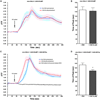DREADDs in Drosophila: a pharmacogenetic approach for controlling behavior, neuronal signaling, and physiology in the fly
- PMID: 24012754
- PMCID: PMC3889141
- DOI: 10.1016/j.celrep.2013.08.003
DREADDs in Drosophila: a pharmacogenetic approach for controlling behavior, neuronal signaling, and physiology in the fly
Abstract
We have translated a powerful genetic tool, designer receptors exclusively activated by designer drugs (DREADDs), from mammalian systems to Drosophila melanogaster to selectively, rapidly, reversibly, and dose-dependently control behaviors and physiological processes in the fly. DREADDs are muscarinic acetylcholine G protein-coupled receptors evolved for loss of affinity to acetylcholine and for the ability to be fully activated by an otherwise biologically inert chemical, clozapine-N-oxide. We demonstrate its ability to control a variety of behaviors and processes in larvae and adults, including heart rate, sensory processing, diurnal behavior, learning and memory, and courtship. The advantages of this particular technology include the dose-responsive control of behaviors, the lack of a need for specialized equipment, and the capacity to remotely control signaling in essentially all neuronal and nonneuronal fly tissues.
Copyright © 2013 The Authors. Published by Elsevier Inc. All rights reserved.
Figures







Similar articles
-
Deschloroclozapine, a potent and selective chemogenetic actuator enables rapid neuronal and behavioral modulations in mice and monkeys.Nat Neurosci. 2020 Sep;23(9):1157-1167. doi: 10.1038/s41593-020-0661-3. Epub 2020 Jul 6. Nat Neurosci. 2020. PMID: 32632286
-
The first structure-activity relationship studies for designer receptors exclusively activated by designer drugs.ACS Chem Neurosci. 2015 Mar 18;6(3):476-84. doi: 10.1021/cn500325v. Epub 2015 Jan 27. ACS Chem Neurosci. 2015. PMID: 25587888 Free PMC article.
-
A Method for Remotely Silencing Neural Activity in Rodents During Discrete Phases of Learning.J Vis Exp. 2015 Jun 22;(100):e52859. doi: 10.3791/52859. J Vis Exp. 2015. PMID: 26131591 Free PMC article.
-
Resolving Behavioral Output via Chemogenetic Designer Receptors Exclusively Activated by Designer Drugs.J Neurosci. 2016 Sep 7;36(36):9268-82. doi: 10.1523/JNEUROSCI.1333-16.2016. J Neurosci. 2016. PMID: 27605603 Free PMC article. Review.
-
Chemogenetic Signaling in Space and Time: Considerations for Designing Neuroscience Experiments Using DREADDs.Neuroscientist. 2024 Jun;30(3):328-346. doi: 10.1177/10738584221134587. Epub 2022 Nov 19. Neuroscientist. 2024. PMID: 36408535 Review.
Cited by
-
G Proteins and GPCRs in C. elegans Development: A Story of Mutual Infidelity.J Dev Biol. 2018 Nov 25;6(4):28. doi: 10.3390/jdb6040028. J Dev Biol. 2018. PMID: 30477278 Free PMC article. Review.
-
Examining Monosynaptic Connections in Drosophila Using Tetrodotoxin Resistant Sodium Channels.J Vis Exp. 2018 Feb 14;(132):57052. doi: 10.3791/57052. J Vis Exp. 2018. PMID: 29553525 Free PMC article.
-
Current techniques for high-resolution mapping of behavioral circuits in Drosophila.J Comp Physiol A Neuroethol Sens Neural Behav Physiol. 2015 Sep;201(9):895-909. doi: 10.1007/s00359-015-1010-y. Epub 2015 Apr 30. J Comp Physiol A Neuroethol Sens Neural Behav Physiol. 2015. PMID: 25925433 Review.
-
Modulatory effects on Drosophila larva hearts: room temperature, acute and chronic cold stress.J Comp Physiol B. 2016 Oct;186(7):829-41. doi: 10.1007/s00360-016-0997-x. Epub 2016 May 21. J Comp Physiol B. 2016. PMID: 27209390
-
Deciphering and modulating G protein signalling in C. elegans using the DREADD technology.Sci Rep. 2016 Jul 27;6:28901. doi: 10.1038/srep28901. Sci Rep. 2016. PMID: 27461895 Free PMC article.
References
-
- Aso Y, Grübel K, Busch S, Friedrich AB, Siwanowicz I, Tanimoto H. The mushroom body of adult Drosophila characterized by GAL4 drivers. J. Neurogenet. 2009;23:156–172. - PubMed
-
- Boyden ES, Zhang F, Bamberg E, Nagel G, Deisseroth K. Millisecond-timescale, genetically targeted optical control of neural activity. Nat. Neurosci. 2005;8:1263–1268. - PubMed
Publication types
MeSH terms
Substances
Grants and funding
LinkOut - more resources
Full Text Sources
Other Literature Sources
Molecular Biology Databases

